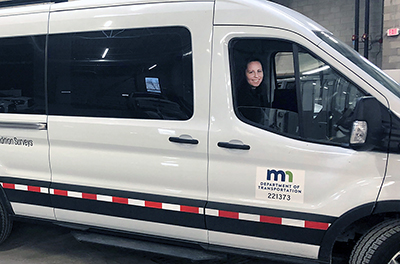By Joseph Palmersheim

Stephanie Clark, data technician, drives tens of thousands of miles each year collecting roadway data for MnDOT. The vehicle she drives (pictured) is equipped with a variety of sensors to measure pavement condition. Photo by Dave Larson |
Stephanie Clark, transportation specialist in the Office of Materials and Road Research, has worked as a data technician at MnDOT for 2.5 years. She is one of three people at the agency who drive vehicles with sensors to gather pavement data.
What do you do in your role?
I collect pavement data for the counties. MnDOT collects pavement condition data on all state highways and one-half of county state aid highways on an annual basis. Testing involves driving each road, in both directions. We measure pavement roughness, rutting, faulting, cracking and other pavement distress. We also collect digital images of the right of way and pavement surfaces. During the off season, I review the data for accuracy and prepare for the upcoming season.
What kinds of skills does your job require?
The skills needed for the job are varied: attention to detail, ability to multitask, understanding the complexity of multiple data collection systems and how they all work together. Knowing how to create and read maps is important in planning and for efficiency while in the field.
How does your vehicle collect data?
Each of our data collection vehicles has a variety of specialized equipment. We have front and side digital cameras, which we use to collect images for our Videolog recording program. The vehicle also has an inertial profiling laser system for roughness measurements, and 3-D lasers for pavement images, crack surveys, and measuring rutting and faulting. Finally, we have GPS.
What is the data used for and why is it important to have?
We used the data for a variety of reasons, but mostly to track conditions of pavement. It can help [agency staff] make decisions on road projects and maintenance.
How many miles would you estimate you drive for work each year?
So many! My guess is that I average 35,000 miles in a season (April through October). This includes roughly 16,000 lane miles for data collection, and the rest is getting to and from the various counties.
What do you find interesting about your work?
I enjoy seeing the different technologies and techniques that go into maintaining roadways. The climate in Minnesota offers unique challenges with pavement. Seeing how the conditions change year over year is very interesting.
This position is unique in that we are limited to the “good weather days,” meaning no rain, no ice or snow. It can be long days, especially when most of it is spent in a vehicle, but the scenery and knowing the value and importance of the data make it worth it.
What’s your favorite part about what you do?
Traveling all across our state - Minnesota offers so many wonderful places. I am constantly amazed at how beautiful it is here. I also enjoy working with a variety of people, hearing stories from different parts of the state, and learning how each county uses the data.
Do you or a co-worker have an interesting job to share with readers? Send us your ideas, and we’ll contact you for more information.
Recent employee profiles:
| 


